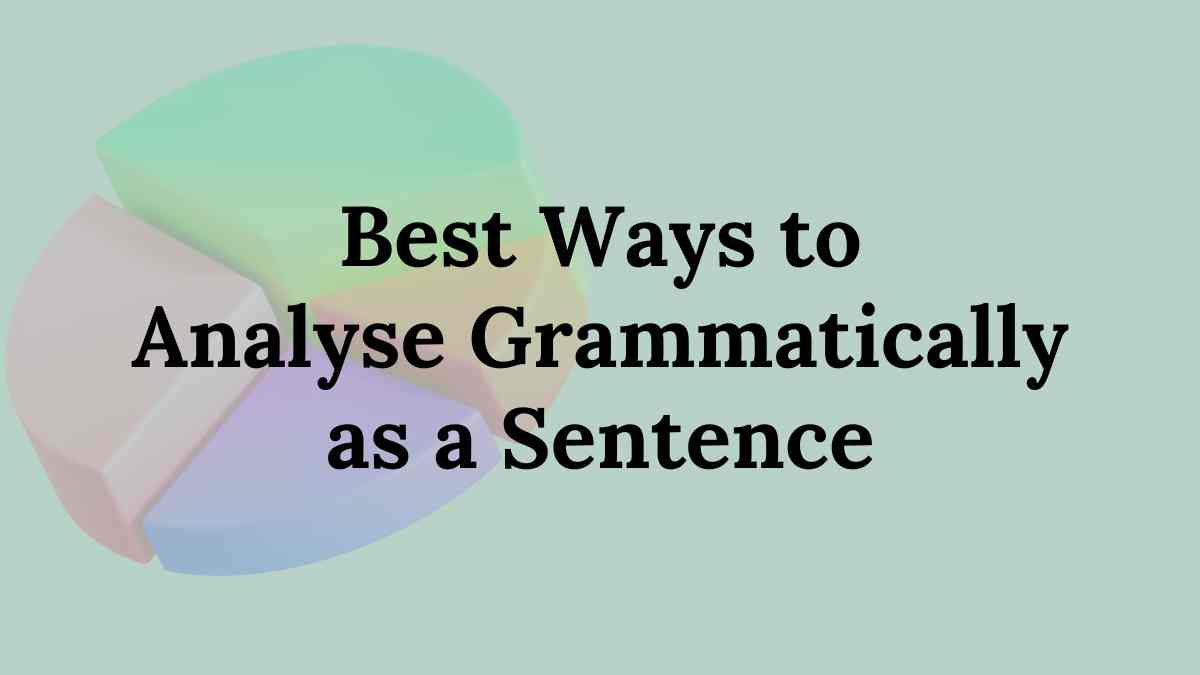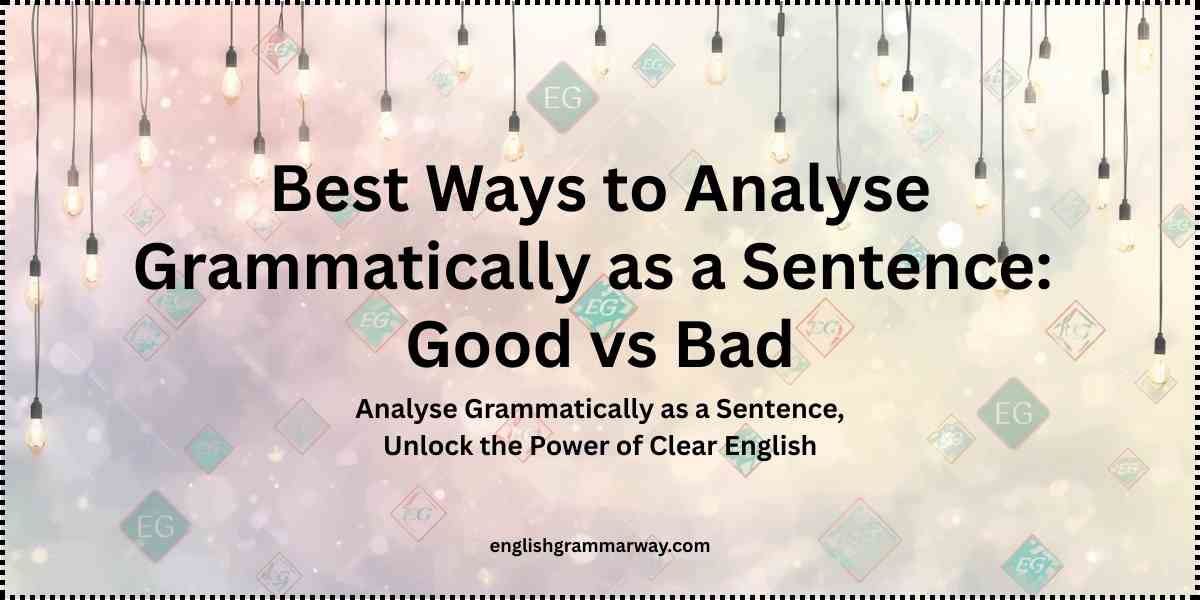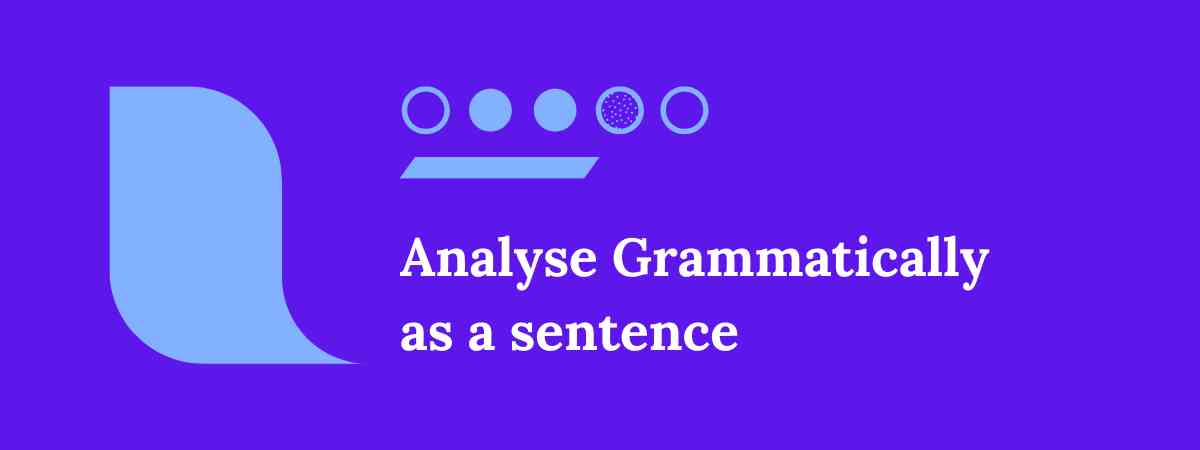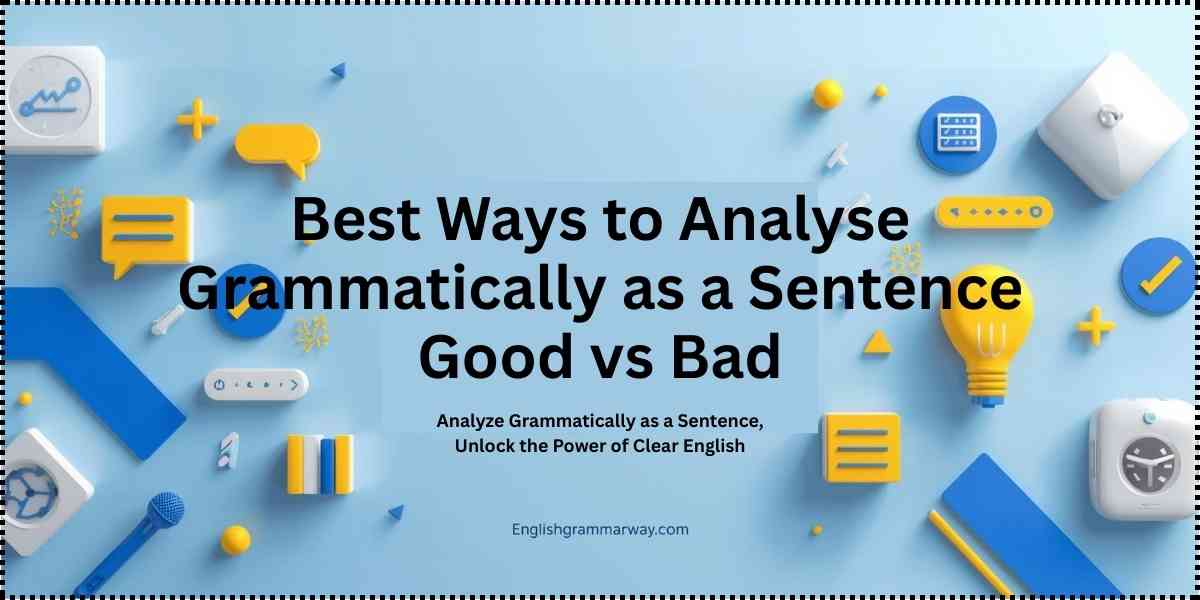When learning English, one of the most powerful skills is the ability to analyze grammatically as a sentence. This means breaking down a sentence to understand how words, phrases, and clauses work together. For students, teachers, and essay writers, this skill is like a grammar check that improves accuracy and clarity. It helps you see both the good and the bad in a sentence so you can correct errors and improve grammar effectively.
In this guide, we will explore five clear and practical ways to analyze grammatically as a sentence. Each method comes with explanations, sentence structure insights, and examples that English learners can apply immediately. By the end, you will have the tools to evaluate sentence quality, avoid common mistakes, and strengthen your understanding of English grammar rules.
Why Learn to Analyze Grammatically as a Sentence
Analyzing a sentence is more than identifying words. It is about seeing how meaning is built. When you analyze grammatically as a sentence, you can:
- Recognize subject and verb agreement
- Identify sentence fragments and run-ons
- Apply correct sentence structure
- Detect common errors using error analysis
- Make writing smoother and more accurate
For English learners, this process is a step toward writing confidently and speaking more clearly. For teachers, it is a way to guide students in error correction and sentence improvement.
1. Identify the Core Sentence Elements
The first way to analyze grammatically as a sentence grammatically is to focus on the core elements. Every complete sentence must have a subject and a predicate.
Subject and Predicate
- The subject tells us who or what the sentence is about.
- The predicate tells us what the subject does or is.
Example:
The student writes an essay.
- Subject: The student
- Predicate: writes an essay
When you perform a grammar check, identifying these two parts helps prevent incomplete sentences.
Common Mistakes to Avoid
- Missing subject: Went to the park. (Who went?)
- Missing predicate: The student in the classroom. What about the student?
By focusing on the subject and predicate, learners can improve grammar step by step.
2. Examine Sentence Structure
The second way to analyze a sentence grammatically is by examining its structure. English grammar rules allow us to build different sentence types depending on how ideas connect.
Types of Sentence Structures
- Simple sentence: one independent clause
- Compound sentence: two independent clauses joined by a coordinator
- Complex sentence: one independent clause and one or more dependent clauses
- Compound-complex sentence: a mix of compound and complex
Example:
- Simple: The teacher explains.
- Compound: The teacher explains, and the student listens.
- Complex: The teacher explains because the topic is important.
- Compound-complex: The teacher explains because the topic is important, and the student listens.
Why Structure Matters
A grammar check often highlights sentence fragments and run-ons. By analyzing structure, learners avoid these problems and write with clarity. Sentence structure analysis is a vital part of error analysis in both academic and daily writing.
3. Break Down Phrases and Clauses
Another way to analyze grammatically as a sentence is to look closely at phrases and clauses.
Phrases
A phrase is a group of words without a complete subject and predicate. Examples include noun phrases, verb phrases, and prepositional phrases.
Example:
- Noun phrase: The bright red car
- Verb phrase: is running fast
- Prepositional phrase: in the classroom
Clauses
A clause has both a subject and a predicate. Clauses can be independent (complete thought) or dependent (incomplete thought).
Example:
- Independent: She studies grammar.
- Dependent: Because she studies grammar
Practical Application
When you analyze grammatically as a sentence, separating phrases and clauses helps identify how ideas connect. This improves grammar and prevents confusion in longer sentences.
4. Apply Error Analysis
Error analysis is the fourth way to analyze grammatically as a sentence. It helps learners identify mistakes and understand why they occur.
Common Errors Found in Sentences
- Subject-verb disagreement: He go to school every day.
- Misplaced modifiers: She almost studied for three hours every day.
- Run-on sentences: He studied he passed the exam.
Correction Through Grammar Check
- Corrected: He goes to school every day.
- Corrected: She studied for almost three hours every day.
- Corrected: He studied, and he passed the exam.
By using grammar check tools or manual review, learners can spot errors and apply English grammar rules correctly. Teachers often encourage students to analyze grammatically as a sentence through error analysis exercises, as this strengthens understanding and reduces mistakes over time.
5. Practice Step-by-Step Analysis
The final way to analyze grammatically as a sentence is through step-by-step practice. Instead of trying to solve everything at once, break the sentence into parts and check each one.
Steps for Practical Sentence Analysis
- Identify the subject and predicate
- Check for correct verb tense and agreement
- Look at sentence structure and type
- Separate phrases and clauses
- Review with error analysis and grammar check
Example Practice:
Sentence: The students in the library were reading quietly.
- Subject: The students
- Predicate: was reading quietly
- Error found: Subject (plural) does not agree with verb (singular)
- Corrected: The students in the library were reading quietly.
Through repeated practice, learners can naturally improve their grammar and gain confidence.
Benefits of Learning to Analyze Grammatically as a Sentence
- Increases accuracy in academic writing
- Improves sentence structure and clarity
- Reduces mistakes during speaking and writing
- Helps in applying English grammar rules effectively
- Builds confidence for both learners and teachers
Analyzing sentences is not just about finding mistakes. It is about understanding the logic of English grammar and applying it to express ideas more effectively.
Common Challenges When You Analyze Grammatically as a Sentence
Many learners struggle in the beginning because analyzing a sentence seems like a complicated task. But with practice, the process becomes easier. Some common challenges include:
- Confusing phrases with clauses
- Not identifying the main verb correctly
- Overlooking subject-verb agreement errors
- Misinterpreting sentence structure
- Forgetting to apply English grammar rules consistently
Example:
Sentence: Running in the park every morning keeps me healthy.
Challenge: Some learners think “running in the park” is the subject, but they may not identify it as a gerund phrase functioning as the subject.
Solution: When you analyze grammatically as a sentence, you learn that “running in the park every morning” is the subject, and “keeps” is the verb.
By practicing these challenges, learners gradually improve their grammar and writing accuracy.
Practical Tips for Students and Teachers
Both students and teachers benefit from learning how to analyze a sentence. Here are some practical strategies:
For Students
- Use a grammar check tool, but always double-check manually.
- Write short sentences first, then move to complex ones.
- Keep a notebook of common errors and corrections.
- Practice rewriting incorrect sentences.
For Teachers
- Teach sentence structure step by step.
- Encourage group activities where students analyze sentences together.
- Provide error analysis worksheets for practice.
- Use real examples from student writing to illustrate good vs bad sentences.
These methods make the learning process engaging and effective.
Step-by-Step Examples of Sentence Analysis
To make things clearer, let’s look at some step-by-step examples of how to analyze a sentence.
Example 1: Simple Sentence
Sentence: The boy plays football.
- Subject: The boy
- Verb: plays
- Object: football
- Structure: Simple sentence
Result: Correct sentence, no errors.
Example 2: Sentence with Error
Sentence: The teachers in the school are busy.
- Subject: The teachers in the school
- Verb: is
- Error: Subject-verb disagreement (plural subject with singular verb)
- Correction: The teachers in the school are busy.
Example 3: Complex Sentence
Sentence: Although it was raining, the children continued playing.
- Clause 1 (dependent): Although it was raining
- Clause 2 (independent): the children continued playing
- Structure: Complex sentence
- Correct usage of subordinating conjunction
By practicing examples like these, learners can improve their understanding of grammar and sentence structure quickly.
Using Error Analysis for Better Learning
Error analysis is not just about pointing out mistakes—it is about learning from them. When you analyze grammatically as a sentence, error analysis helps highlight patterns of errors that often repeat.
Common Student Errors:
- Mixing up verb tenses: She went to school yesterday.
- Using fragments: Because he was late.
- Misplaced modifiers: He almost drove his children to school every day.
Corrections:
- She went to school yesterday.
- He was late. (or expand into a full sentence)
- He drove his children to school almost every day.
By focusing on these corrections, students gain confidence in applying English grammar rules, and teachers can guide them effectively.
Practice Exercises
Here are some exercises to help learners practice how to analyze grammatically as a sentence:
Exercise 1: Identify Errors
Find the mistake in each sentence and correct it.
- The book on the table is mine.
- She doesn’t like coffee.
- Walking through the park makes me relax.
- He is a teacher in the school.
Answers:
- The book on the table is mine.
- She doesn’t like coffee.
- Correct sentence.
- He is a teacher at the school.
Exercise 2: Sentence Structure Check
Label each sentence as simple, compound, complex, or compound-complex.
- I enjoy reading, but my brother prefers sports.
- Because it was late, we decided to go home.
- She writes essays.
- He wanted to study, yet he was too tired, so he went to bed.
Answers:
- Compound
- Complex
- Simple
- Compound-complex
These exercises show how easy it is to improve grammar when you analyze grammatically as a sentence through step-by-step practice.
FAQs About Sentence Analysis
1. What does it mean to analyze grammatically as a sentence?
It means breaking a sentence into its components (subject, verb, object, phrases, clauses) and checking if it follows English grammar rules.
2. Why is it important to analyze sentences?
Because it helps improve grammar, avoid mistakes, and make writing clearer and more professional.
3. Can grammar check tools replace manual analysis?
No, grammar check tools are helpful, but only humans can understand sentence meaning and context properly. That is why students must still learn to analyze grammatically as a sentence.
4. How often should I practice sentence analysis?
Daily practice is best. Even analyzing three to five sentences a day builds strong grammar skills.
Advanced Insights: How to Analyze Grammatically as a Sentence
By now, you already know the basic methods of breaking down sentences into subjects, predicates, phrases, and clauses. But sentence analysis does not stop there. If you want to improve grammar and writing at an advanced level, you must explore deeper strategies. Let us expand our understanding with more detailed techniques.
The Role of Parts of Speech
One of the most effective ways to analyze a sentence is by identifying the parts of speech. Each word plays a role, and when you know that role, you can apply English grammar rules more effectively.
Examples of Parts of Speech in Sentences
- The small child quickly ran to his mother.
- Noun: child, mother
- Adjective: small
- Adverb: quickly
- Verb: ran
- Preposition: to
- Pronoun: his
- They are studying very hard for the exam.
- Pronoun: They
- Verb: are studying
- Adverb: very hard
- Preposition: for
- Noun: exam
When you analyze grammatically as a sentence using parts of speech, you gain a sharper understanding of how meaning is built.
Tense and Time Reference in Sentence Analysis
Another important aspect when you analyze grammatically as a sentence is recognizing tense. Verb tense shows when the action happens, and many students make mistakes in this area, so practicing tense recognition is essential.
Example Sentences
- Present tense: She writes every day.
- Past tense: She wrote yesterday.
- Future tense: She will write tomorrow.
- Perfect tense: She has written many essays.
When you analyze grammatically as a sentence, always ask: Does the verb tense match the intended time? This helps in both grammar check and error analysis.
Voice and Sentence Analysis
Another advanced method is examining active and passive voice.
- Active: The teacher explained the rule.
- Passive: The rule was explained by the teacher.
Both are correct, but the choice depends on emphasis. Teachers often encourage students to use the active voice in academic writing because it is clearer. Still, passive voice is useful when the subject is unknown or unimportant.
Analyzing sentences through voice gives learners flexibility in sentence structure.
Sentence Variety and Style
When you analyze grammatically as a sentence, it is not only about correctness but also about style. Using only short, simple sentences can make writing boring. On the other hand, using too many long, complex sentences can confuse the reader.
Example Comparison
- Too simple: He went home. He ate food. He slept.
- Too complex: After he went home from work, feeling tired and exhausted, he ate the food that his mother had cooked before finally deciding to sleep.
- Balanced: He went home, ate food, and then slept because he was tired.
Good writing uses a mix of sentence structures for variety.
Cultural and Contextual Use
Grammar analysis is not just about rules—it is also about context. Sometimes a sentence is grammatically correct but sounds unnatural.
Example:
- Grammatically correct: She is older than me.
- Natural English: She is older than I am.
When you analyze grammatically as a sentence, you must also think about natural usage. Teachers can highlight these differences for learners.
Common Mistakes Learners Make
While practicing sentence analysis, students often repeat the same mistakes.
Let us examine a few:
- Confusing adjectives and adverbs
- Wrong: She sings beautifully.
- Correct: She sings beautifully.
- Forgetting articles (a, an, the)
- Wrong: He bought a car yesterday.
- Correct: He bought a car yesterday.
- Using wrong prepositions
- Wrong: She is good at math.
- Correct: She is good at math.
By including these in error analysis, students learn to improve their grammar step by step.
Teacher’s Perspective: How to Train Students
Many teachers want to know the best way to help students analyze grammatically as a sentence. The following classroom strategies can be useful:
- Sentence Diagramming
Drawing diagrams that show sentence structure visually helps students see relationships between words. - Peer Correction
Students can exchange written work and analyze each other’s sentences. This builds collaboration and deeper understanding. - Daily Sentence Drill
Teachers can begin class with one sentence written on the board. Students must analyze it for subject, verb, structure, and errors.
These methods make grammar learning practical and interactive.
Step-by-Step Advanced Practice
Let us practice again, but with more challenging sentences.
Example 1
Sentence: The book that I borrowed from the library was very interesting.
- Subject: The book
- Clause: that I borrowed from the library (adjective clause)
- Predicate: was very interesting
- Type: Complex sentence
Example 2
Sentence: He had been working all night, so he was very tired, but he still finished his project.
- Independent clause 1: He had been working all night
- Independent clause 2: he was very tired
- Independent clause 3: he still finished his project
- Coordinators: so, but
- Type: Compound-complex sentence
This level of practice trains students to analyze grammatically as a sentence in academic or professional writing.
Applying Sentence Analysis in Essay Writing
Many learners wonder how this skill helps in essays. When you analyze grammatically as a sentence, you:
- Avoid run-on sentences that reduce clarity
- Build better thesis statements and topic sentences
- Use correct sentence structure for arguments
- Strengthen transitions between ideas
Before Analysis: Essay writing is hard because students do not know grammar rules.
After Analysis: Essay writing is hard because students do not know grammar rules.
A simple sentence correction can change the professionalism of your essay.
Benefits Beyond the Classroom
The ability to analyze grammatically as a sentence is not limited to exams or essays. It helps in:
- Writing emails correctly
- Preparing job applications
- Improving spoken English clarity
- Understanding formal documents
For teachers, it provides a reliable way to guide learners. For students, it gives confidence in both academic and daily communication.
Extended Exercises
Try these exercises for extra practice.
Identify and Correct the Errors
- She has finished her homework.
- The people in the village are friendly.
- I enjoyed playing football yesterday.
Correct Answers:
- She has finished her homework.
- The people in the village are friendly.
- I enjoyed playing football yesterday.
Identify Sentence Structure
- While I was reading, the phone rang.
- The dog barked, and the cat ran away.
- He studied hard.
Answers:
- Complex
- Compound
- Simple
By practicing these, you will improve your grammar and become skilled at error analysis.
Conclusion
The journey to analyze grammatically as a sentence is not just about memorizing rules. It is about understanding language deeply, applying English grammar rules in context, and correcting mistakes through practice.
By focusing on parts of speech, verb tense, voice, sentence variety, and context, learners can move from basic grammar check to advanced analysis. Teachers can guide students with structured drills, error analysis activities, and real-world applications.
In the end, the ability to analyze grammatically as a sentence makes you a stronger communicator. It helps you avoid errors, write essays more effectively, and improve grammar in both spoken and written English. With regular practice, this skill becomes a natural part of your language learning journey.



